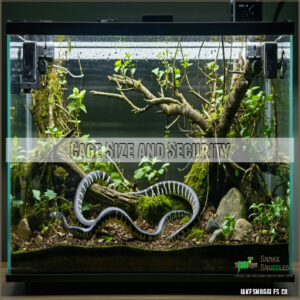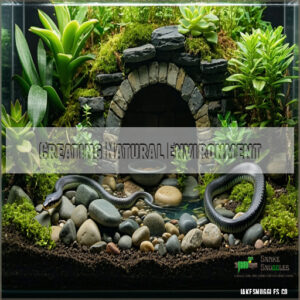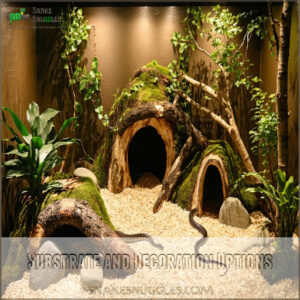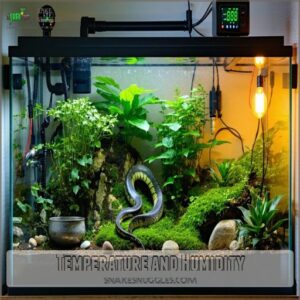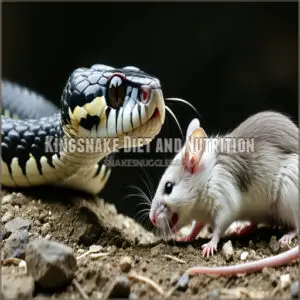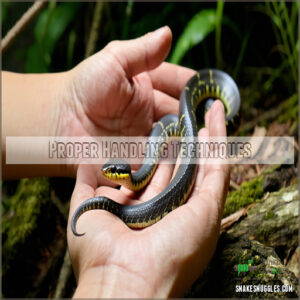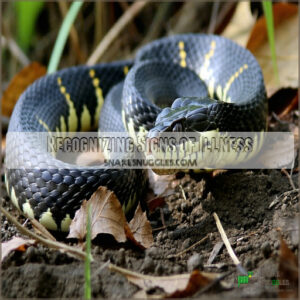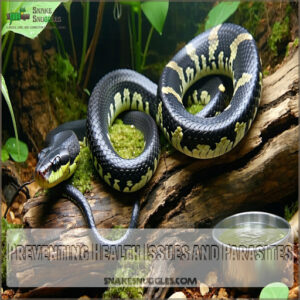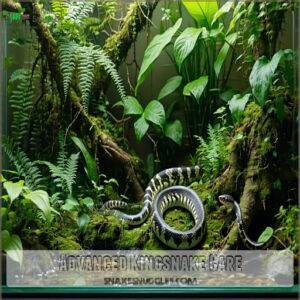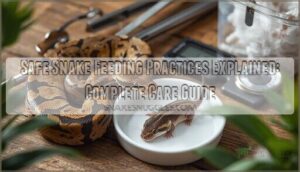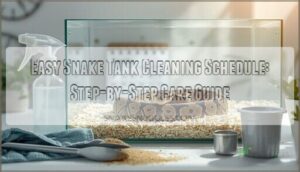This site is supported by our readers. We may earn a commission, at no cost to you, if you purchase through links.

You’ll want a temperature gradient (85-90°F basking, 70-75°F cool side) and 50-60% humidity.
Aspen or coconut coir bedding works well, along with hide boxes and climbing branches.
Feed your kingsnake frozen-thawed mice or rats every 10-14 days (adults), ensuring the prey is no larger than 1.5 times its head.
Handle your snake gently and support its body, and there’s much more to discover about thriving California kingsnake care.
Table Of Contents
- Key Takeaways
- California Kingsnake Housing
- Temperature and Humidity
- Kingsnake Diet and Nutrition
- Handling and Health Care
- Advanced Kingsnake Care
- Frequently Asked Questions (FAQs)
- Are California kingsnakes easy to take care of?
- Do California kingsnakes like to be held?
- What size tank does a California kingsnake need?
- How often should I feed a California kingsnake?
- Do California kingsnakes need heat at night?
- How long do California kingsnakes live in captivity?
- Do California kingsnakes need UV light?
- How often should I spot clean the enclosure?
- What are signs of a healthy kingsnake?
- Can kingsnakes live with other snakes?
- Conclusion
Key Takeaways
- You’ll need a secure enclosure (20+ gallons) with a locking lid, a temperature gradient (85-90°F basking, 70-75°F cool side), and 50-60% humidity. Use aspen or coconut coir bedding, hide boxes, and climbing branches.
- Feed your kingsnake frozen-thawed mice or rats every 10-14 days (adults), ensuring the prey is no larger than 1.5 times its head.
- Handle your snake gently, supporting its body. Avoid handling during shedding or digestion. Start slow, with short sessions.
- Monitor your snake for health issues like labored breathing, nasal discharge, mouth rot, or skin changes. Keep the enclosure clean and provide fresh water.
California Kingsnake Housing
Your California kingsnake needs a secure enclosure that provides ample space to explore and hide.
By mimicking natural conditions with the right substrate, decorations, and temperature control, you’ll create a safe and comfortable habitat for your snake.
Cage Size and Security
A proper kingsnake enclosure starts with cage size and security.
For adults, choose a 20-gallon tank or larger.
Use secure lids with locking mechanisms to prevent escapes—California kingsnakes are great at finding cracks.
Opt for sturdy cage materials like glass or plastic with strong ventilation systems.
Always double-check your snake enclosure for gaps to avoid surprise escapes and guarantee safety.
When selecting a suitable enclosure, consider the tank size options available to provide the best environment for your kingsnake.
Creating Natural Environment
Creating a natural kingsnake habitat means blending function with design.
Use small rock features for climbing and shelter, water elements like shallow dishes for hydration, and plant arrangements (fake or real) to mimic their environment.
Focus on soil quality and temperature gradients with substrate options that complement this setup.
UVB lighting adds flair while promoting a healthy, well-lit snake enclosure, which is crucial for a natural kingsnake habitat and overall snake enclosure.
Substrate and Decoration Options
A well-designed kingsnake habitat starts with the right substrate.
Aspen bedding is clean and perfect for burrowing, while coconut coir retains moisture well.
Add hide boxes for security, decorative rocks for texture, and climbing structures for activity.
Plant arrangements—real or fake—can boost aesthetics and mimic nature.
Just make sure the enclosure stays practical and easy to clean for your kingsnake.
For ideal snake health, using proper aspen bedding products is highly recommended to maintain a clean environment.
Temperature and Humidity
You’ll need to keep your California kingsnake’s enclosure at the right temperature and humidity for them to stay healthy and active.
Setting up a proper temperature gradient and maintaining moderate humidity levels isn’t hard, but it’s essential for their comfort and well-being.
Temperature Gradient Requirements
Thermal zones keep your kingsnake comfortable by mimicking its natural habitat.
To set up a proper temperature gradient:
- Place a heat source for basking, maintaining 85-90°F on the warm side.
- Keep the cooler side at 70-75°F for temperature control.
- Use a thermal gradient system with heat lamps or pads.
- Avoid burns—ensure snakes can’t reach hot surfaces.
Proper temperature gradient control is essential for maintaining a healthy environment for your kingsnake.
Maintaining Humidity Levels
Humidity levels matter just as much as temperature.
Aim for 50-60% humidity using water bowls, misting systems, or fogging equipment.
A hygrometer helps with precise calibration to avoid swings.
Kingsnake care benefits from spot misting occasionally or placing water bowls on the cool side for balance.
Keep humidity versatile in reptile care, promoting healthy shedding and thermoregulation.
| Tool/Method | Usage | Frequency | Placement | Tips |
|---|---|---|---|---|
| Hygrometer | Monitor humidity levels | Daily | Across enclosure | Regular calibration |
| Misting | Add moisture to the air | 1-2 times/day | Cool enclosure side | Spot mist as needed |
| Fogger | Disperse humidity evenly | As required | Center | Use for high traffic |
| Water Bowls | Increase ambient moisture | Always | Cool side | Keep clean and fresh |
| Substrate | Retain some humidity | As needed | Across ground base | Avoid over-saturating |
Heating and Cooling Equipment
Keeping your kingsnake’s home at the right temp is a breeze with the right thermal controls.
Heat mats, undertank pads, and ceramic elements are go-to heating options.
Heat lamps are another popular choice, but they can dry out the air.
For cooling, fans or air cons are ideal.
Temperature sensors and thermostats are key to maintaining a steady climate.
With the right heating elements and thermostat settings, your snake will thrive.
When choosing heating solutions, consider using heat mat products to guarantee a stable and warm environment for your pet.
Kingsnake Diet and Nutrition
As a carnivore, your California kingsnake’s diet primarily consists of whole animal prey, typically rodents.
This section will cover feeding frequency, prey selection, and hydration requirements to guarantee your pet snake stays healthy and happy.
Feeding Frequency and Techniques
Feeding your kingsnake doesn’t have to be a challenging task.
You can guarantee your scaly friend gets the nutrition it needs with these simple tips:
- Feeding Schedules: Depending on their age, feed hatchlings every 5-7 days, juveniles every 7-10 days, and adults every 10-14 days.
- Prey Items: Offer frozen-thawed mice or rats, guaranteeing the prey is no larger than 1.5 times the size of your snake’s head.
- Meal Timing: Feed your snake in the early morning or at night when they’re most active.
- Snake Nutrition: A varied diet of rodents provides a balanced nutrient profile for your kingsnake.
Prey Selection and Size
Kingsnakes are constrictors with a taste for variety.
While they’ll eat other snakes, even venomous rattlers, you should offer a safer menu.
In the wild, they gobble up small animals and birds.
In captivity, their diet is mostly rodents, like mice.
Adult mice can wound your snake, so go for fresh-killed or frozen-thawed.
Use this feeding chart for prey size and frequency: Understanding the colubrid snake habits can help you create a suitable diet plan.
| Snake Size | Prey Type | Feeding Frequency |
|---|---|---|
| Juveniles | Pinkie Mice, Small Adult Mice | Once or Twice a Week |
| Adults | Large Mice or Rats | Every 10-14 Days |
Water and Hydration Needs
Water quality is key for your kingsnake’s health, so provide fresh water in a bowl deep enough for submersion without flooding.
Snakes don’t drink from standing water, so make certain regular cleaning and scrubbing of the water bowl with veterinary disinfectant.
Keep a close eye on fluid intake, especially during warmer months when hydration needs peak.
Maintaining ideal humidity levels through misting also contributes to your snake’s overall hydration.
Handling and Health Care
Handling your California kingsnake is an important part of bonding and ensuring its comfort.
We’ll cover the best handling techniques, recognizing signs of illness, and preventing common health issues and parasites to keep your pet snake happy and healthy.
Proper Handling Techniques
Snake handling is an art, and with California kingsnakes, it’s all about gentle support.
Here are some tips to master it:
- Wait for the right time: Let your snake settle in for a couple of weeks and verify it’s eating regularly before you start handling.
- Slow and steady: Always support their body and move slowly when handling.
- Frequency and duration: Handle them at least weekly but no more than once daily, keeping initial sessions to 5 minutes.
- No feeding or shedding interruptions: Avoid handling during digestion or shedding.
- Calming methods: If your kingsnake is nervous, give it time to adjust and try gentle handling techniques.
Understanding proper corn snake handling can also provide valuable insights into handling other snake species, including kingsnakes.
Recognizing Signs of Illness
Keep an eye out for these common health red flags in your kingsnake: labored breathing, nasal discharge, mouth rot (look for cheesy gunk around their gums), skin bumps, or discolorations.
Irritability and loss of appetite during shedding are also signs something’s up.
If they miss meals or vomit, get them to a vet.
Use the table below as a quick reference guide for potential health issues.
| Health Issue | Symptoms | Cause |
|---|---|---|
| Respiratory Problems | Labored breathing, nasal discharge | Cold or humid environment |
| Stomatitis (Mouth Rot) | Cheesy substance around gums | Debris in snake’s mouth |
| Skin Problems | Bumps, discolorations | Skin mites |
Preventing Health Issues and Parasites
Parasite control and health monitoring are key to disease prevention and your snake’s overall well-being.
Here are some tips for keeping your kingsnake healthy and parasite-free:
- Snake Hygiene: Keep the enclosure clean and disinfected to prevent the spread of parasites and bacteria.
- Remove feces and urates daily and replace the substrate every 3–4 months.
- Infection Treatment: Be vigilant for respiratory infections, a common issue.
- Maintain ideal temperatures to prevent colds and pneumonia.
- Mouth Care: Check for mouth rot and ulcerative stomatitis, which can be caused by foreign objects.
- Parasite Treatment: Ticks and mites are common parasites.
- Use recommended treatments to keep your snake parasite-free.
Advanced Kingsnake Care
As your kingsnake settles into its new home, you’ll want to keep it entertained and thriving.
This section will explore advanced care topics, including environmental enrichment, breeding, and the unique challenges of caring for hatchlings and juveniles.
Environmental Enrichment Options
Keep your kingsnake entertained and enriched with a variety of sensory stimulation options.
Offer environmental toys, like climbing structures and hiding places, to create a dynamic and interesting space.
Visual barriers, like fake plants or rocks, provide security and a sense of adventure.
Regularly rotate and rearrange the substrate and hides to encourage exploration.
UVB light is essential for their health and well-being, so be sure to include that in their enclosure.
By incorporating elements that support a snake friendly environment, you can create a thriving space that meets your kingsnake’s physical and psychological needs.
Breeding and Cycling Techniques
Beyond enriching their environment, consider kingsnake breeding.
Understanding kingsnake cycling and captive breeding is key.
For successful snake mating, introduce females after shedding, as copulation lasts several hours.
Proper egg incubation at 80-82°F is essential for healthy hatchlings.
Breeding methods and cycle timing greatly influence kingsnake care and breeding success.
Caring for Hatchlings and Juveniles
For ideal hatchling development and neonate health, house young California kingsnakes individually in appropriately sized enclosures.
A kingsnake diet for juveniles consists of appropriately sized mice offered every 5-7 days to support rapid snake growth.
Closely monitor young care, observing kingsnake behavior and ensuring proper temperature and humidity for these delicate youngsters.
Diligent juvenile feeding and thorough attention to their snake enclosure contribute substantially to raising thriving California kingsnakes.
Frequently Asked Questions (FAQs)
Are California kingsnakes easy to take care of?
Yes, California kingsnakes are generally easy to care for. Their manageable size, docile nature, and simple dietary needs make them great for beginners.
Do California kingsnakes like to be held?
Imagine a California kingsnake, sleek and patterned, basking in the warmth of your hand. While tolerant of handling, they aren’t cuddly. Regular, gentle interaction builds trust, but respect their nature.
What size tank does a California kingsnake need?
For adult California kingsnakes, you’ll need at least a 20-gallon terrarium, but a 40-gallon (or larger) tank is better for bigger snakes. Make sure it’s escape-proof!
How often should I feed a California kingsnake?
Hatchlings eat every 5-7 days, juveniles every 7-10 days, and adults every 10-14 days. Match prey size to your snake’s width, roughly 10% of its body weight.
Do California kingsnakes need heat at night?
California kingsnakes don’t need nighttime heat unless your room temperature drops below 65°F. If it does, use a ceramic heat emitter or under-tank heater to maintain a safe temperature gradient.
How long do California kingsnakes live in captivity?
With proper care, you can expect your California kingsnake to live a long and healthy life, typically reaching 15-20 years in captivity, sometimes even longer.
Do California kingsnakes need UV light?
While not strictly necessary, UVB lighting can boost your kingsnake’s overall health and well-being. Consider adding a UVB bulb with a UV Index of 0-
How often should I spot clean the enclosure?
Like tending a garden, daily removal of waste is essential. For a pristine kingsnake habitat, replace soiled substrate and spot clean regularly, ensuring a healthy environment.
What are signs of a healthy kingsnake?
A healthy kingsnake has bright eyes, clear nostrils, smooth scales, a robust appetite, and regular shedding. It’s alert, curious, and flicks its tongue frequently.
Can kingsnakes live with other snakes?
Imagine two kingsnakes, rivals in a shared terrarium, battling for dominance. Kingsnakes, especially different species, shouldn’t cohabitate. Competition for resources and potential predation create a risky environment.
Conclusion
Did you know California kingsnakes can live up to 20 years in captivity.
Providing proper California kingsnake care guarantees your snake thrives.
Recap: a secure enclosure with appropriate temperature gradients, humidity, and enrichment is vital.
Offer frozen-thawed prey appropriate to your snake’s size.
Handle your kingsnake gently and confidently, always monitoring for signs of illness.
With diligent California kingsnake care, you’ll enjoy years with this fascinating reptile.
- https://allanspetcenter.com/care-sheet-how-to-care-for-california-kingsnakes/
- https://reptilesmagazine.com/california-kingsnake-care-sheet/
- https://reptifiles.com/kingsnake-care-sheet/
- http://www.exoticpetvet.com/california-kingsnake-care.html
- https://www.reptilebasics.com/arcadia-forest-6-uvb/arcadia-d3-6-uvb-t5-bulb-22/

